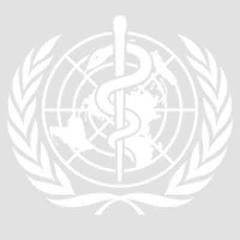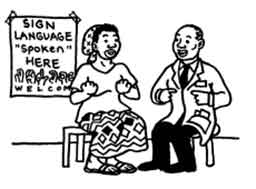Your progress
0%
Here are some of the most important ideas you need to understand in order to ensure that people with disabilities and their families are able to obtain the health services that they need.
Use your mouse or keyboard to expand each of the headings below.
Health has been defined by WHO as “a state of complete physical, mental and social well-being and not merely the absence of disease or infirmity”.
Health is a valuable resource that enables people to lead individually, socially and economically productive lives, providing them with the capacity to work, learn and fully engage in family and community life.
See how a CBR worker in India was able to help a deafblind girl take her first steps towards a better state of well-being.


Khurshida was born deafblind in a small village in Uttar Pradesh, India.
When Satyabhama, a CBR worker trained by Sense International India, met her, Khurshida was 10 years old and had spent most of her life lying in a dark corner of the family home, completely isolated from her community. She was unable to communicate, and completely dependent on her mother for all her needs.
Satyabhama worked hard with Khurshida to teach her daily living and communication skills. Khurshida began to respond positively by sitting up, eating meals with her family and playing with toys. She began to learn the language of touch, discovering that by pulling at her mother’s sari it would make her stay a little while longer.
With time, Satyabhama was able to take Khurshida by the hand and encourage her to take her first steps outside the family home. She may not have heard the birds sing or seen the sun, but the expression on her face showed that she loved the feel of the gentle fresh breeze against her face. The CBR programme was able to help Khurshida’s family obtain a disability certificate for her, which enabled access to a wide range of services. The programme also assisted Khurshida’s mother to access treatment for tuberculosis.
Satyabhama continues to work with Khurshida and is now teaching her sign language. It will be a long journey for Khurshida and her family, but with the support of CBR they are working towards the full inclusion of Khurshida in the life of her community.
A person’s health status is influenced by a wide range of personal, economic, social and environmental factors. These factors are commonly referred to as determinants of health and include:
The social determinants of health are the social conditions in which people are born, grow, live, work and age. These circumstances are shaped by the distribution of income, power and resources at global, national and local levels.
The social determinants of health are responsible for health inequities, which are not merely differences in health, but differences in access to the resources needed for better health. To address health inequities, WHO Member States adopted the Rio Political Declaration on Social Determinants of Health at the World Conference on Social Determinants of Health in Rio de Janeiro, Brazil in October 2011, calling for action in five areas:
Health for All was a global health objective set by WHO during the International Conference on Primary Health Care (Alma-Ata, USSR, 6–12 September 1978). Today, communities globally have yet to achieve this objective.
To ensure that people with disabilities achieve good levels of health, it is important to remember that:
Health care is provided by the health system, which comprises all those organizations, institutions, resources and people whose primary purpose is to promote, restore or maintain health and enhance functioning. While the ultimate responsibility for the health system lies with the government, most health care is provided by a combination of public, private, traditional and informal sectors.
The 2008 World Health Report emphasizes the essential role of primary health care in achieving health for every person. Primary health care is essential health care and should be made universally accessible to individuals and families at a cost they can afford. It is the first level of contact with the national health system for individuals, families and communities, and should bring health care as close as possible to where people live and work.
The poor health that people with disabilities may experience may, or may not, be a direct result of having a disability; it can also be linked to difficulties in accessing health services and programmes.
The barriers to health-care services that people with disabilities and their family members may face include:
Poll question: Which one of the barriers mentioned above do you believe is most significant in your community?
Some people with disabilities may be more vulnerable to discrimination and exclusion than others. They may suffer double or multiple disadvantages, due to the type of disability they have, their age, gender or social status.
CBR should be particularly mindful of the following groups:

“Inclusive education” is increasingly being implemented in education systems throughout the world. It refers to education that welcomes all people, including those with disabilities, to participate fully in regular schools or centres of learning.
Similarly, the concept of inclusive health is now being promoted by CBR to ensure that health systems recognize and accommodate the needs of people with disabilities in their policies, planning and service delivery. It builds on the “Health for All” concept of primary health care, which states that health care should be “… accessible to individuals and families in the community through their full participation and at a cost that the community and the country can afford”.
Inclusive health means that all individuals can access health care irrespective of impairment, gender, age, colour, race, religion and socioeconomic status. To ensure this, health-care service providers need to have positive attitudes towards disability and people with disabilities and have the appropriate skills, such as communication skills to accommodate the needs of people with different impairments.
Learn how a young Pakistani man with a hearing impairment overcame the difficulty of communicating with his doctor.


Muhammad Akram is from Sindh Province, Pakistan. He became deaf as a teenager due to an illness. The following anecdote describes his experience of visiting a doctor with his family.
“Being deaf I was always unaware of what they were talking about. If I asked the doctor a question he usually replied that he had told my family everything. And if I asked my family a question they always said “don’t worry, nothing special” or “we will tell you later”. Nobody really told me anything. No one used sign language and nobody had the time or willingness to communicate with me using pen and paper. Over time I began to lose my confidence and became very dependent on others.
“After joining a CBR programme I slowly gained confidence and developed the courage to face the challenges myself. I started refusing to take a family member with me to the doctor. This forced the doctor to communicate with me directly in writing. Some doctors still ask me to bring someone with me on my next visit but I always tell them that I am an adult. I feel good as I have developed self-confidence and have also helped to raise the profile of disability by educating medical professionals.”
CBR can facilitate access to health care for people with disabilities by working with primary health care in the local community, providing the much-needed link between people with disabilities and the health-care system.
In many countries, including Argentina, Indonesia, Mongolia and Viet Nam, CBR activities are directly linked with the health-care system. They are managed by the ministry of health and implemented through primary health care structures.
In other countries, CBR is managed by nongovernmental organizations or other government ministries such as social welfare. In these situations, close contact must be maintained with primary health care to ensure that people with disabilities can access health care and appropriate rehabilitation services as early as possible.